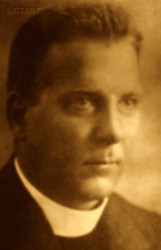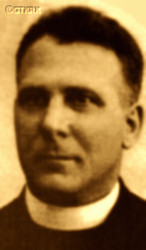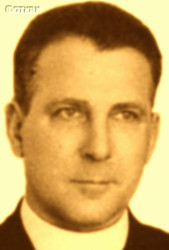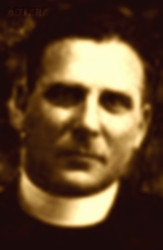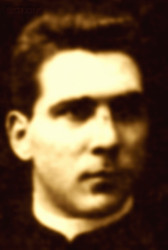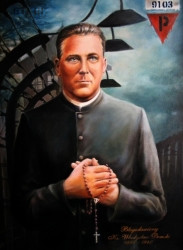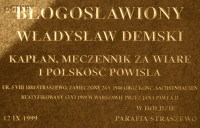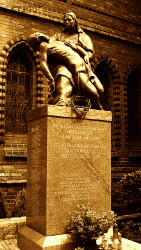Roman Catholic
St Sigismund parish
05-507 Słomczyn
85 Wiślana Str.
Konstancin deanery
Warsaw archdiocese, Poland
full list:
displayClick to display full list

searchClick to search full list by categories
wyświetlKliknij by wyświetlić pełną listę po polsku

szukajKliknij by przeszukać listę wg kategorii po polsku

Martyrology of the clergy — Poland
XX century (1914 – 1989)
personal data
religious status
blessed
surname
DEMSKI
forename(s)
Vladislav (pl. Władysław)
beatification date
13.06.1999more on
www.swzygmunt.knc.pl
[access: 2013.05.19]

the RC Pope John Paul IImore on
en.wikipedia.org
[access: 2014.09.21]
function
diocesan priest
creed
Latin (Roman Catholic) Church RCmore on
en.wikipedia.org
[access: 2014.09.21]
diocese / province
Gniezno and Poznań archdiocese (aeque principaliter)more on
www.archpoznan.pl
[access: 2012.11.23]
Warmia diocesemore on
en.wikipedia.org
[access: 2018.09.02]
honorary titles
Gold „Cross of Merit”more on
en.wikipedia.org
[access: 2019.04.16]
(28.01.1939)
date and place
of death
28.05.1940

KL Sachsenhausenconcentration camp
today: Sachsenhausen‐Oranienburg, Oberhavel dist., Brandenburg state, Germany
more on
en.wikipedia.org
[access: 2018.11.18]
alt. dates and places
of death
26.05.1940
details of death
In 1915‐1916, during World War I 1914‐1918, chaplain of the German Imperial Army in Königsberg, working, among other things, with Polish prisoners of war from the Russian Imperial Army, interned by the Germans.
After the end of World War I on 11.11.1918 and the creation of an independent Polish state, at the peace conference in Versailles on 28.06.1919, the Entente countries decided to hold a plebiscite in part of Warmia, Masuria and Powiśle, which was to decide on the state affiliation of these lands. Became then a collaborator of the Warmia Plebiscite Committee. The plebiscite, which took place on 11.07.1920, at probably the worst time for the Poles — at a time when the great Russian offensive was beginning during the Polish–Russian War of 1919–1921 — ended in defeat for Poland.
Among others, although in his parish village, Stary Targ, the majority of the inhabitants voted for affiliation to Poland, in the commune it was different. The village remained within the borders of Germany.
Became then, on 30.11.1920, a co‐founder and member of the central committee of the Union of Poles in East Prussia (which later, in 1924, became part of the Union of Poles in Germany). Became also vice‐chairman of the Polish–Catholic School Society for Warmia.
However, on 17.08.1922, was forced by the Germans to leave his native Powiśle.
After German and Russian invasion of Poland in 09.1939 and start of the World War II, after start of German occupation, after arrest of Fr Stanislav Kubski took post of the parish priest of the Annunciation of the Blessed Virgin Mary parish in Inowrocław.
On 02.11.1939, Polish Catholic priests working in Inowrocław and the surrounding area were „invited” by the Germans to a meeting at the starosty office, in order to ‐ as it was announced ‐ „discuss the conditions of pastoral work during the war”. When they showed up, all were arrested. As it turned out, only 13 out of the 34 detainees survived the German occupation.
Jailed in Inowrocław prison.
On 05.11.1939 moved to VSH Schwetz custody in Świecie, and next on 08.11.1939 to Górna Grupa transit camp.
On 05.02.1940 transported to ZL Neufahrwasser in Gdańsk transit camp and from there on 08.02.1940 to KL Stutthof concentration camp.
There slaved at road paving stones manufacture at ZL Grenzdorf sub‐camp, among others.
Finally on 09‐10.04.1940 moved to KL Sachsenhausen concentration camp.
There, in barrack No. 20, a 22‐year–old German assistant to the Germ. Blockführer (Eng. block commander) began to abuse him. Beat him with a baton, poured cold water on him. As a result, developed kidney disease, his legs began to swell, and then his whole body, ulcers appeared.
As a patient, transferred to another block. There, forced to participate in all‐day penal gymnastic exercises, including the so‐called „frogs” — squats in a jump, for many hours. When weakened, was beaten with sticks and kicked in the back, kidneys, groin.
On 26.05.1940, during a clothing inspection, a rosary (or a cross or a medallion) fell out of one of the bundles in which the prisoners' clothes were tied. The bored SS‐men called him over and ordered him to trample on the rosary.
Refused.
One of the SS‐men picked up the rosary and threw it in the mud, then ordered him to kiss it. Knelt down and leaned over the rosary.
Then the beatings began‐with a thick stick, a reed staff. Hit him on the head, on the back, on the kidneys.
When fell, still without uttering a single word, the torturers began to kick him and walk on him.
After everything, when was led to the barracks, is said to have whispered: „You have to endure everything and complain about nothing”.
Two days later, during roll call, slumped to the ground.
After roll call, was carried to the fence, where lay on the ground dying for a long time, surrounded by priests.
According to the death certificate in the books of the Germ. Standesamt (Eng. registry office) in Oranienburg, No. 2776/40, the „honest” otherwise German „medical doctors” and formalists — and at the same time, unrivaled fairy tale spinners — noted that the cause of death was Germ. „Herzschwäche” (Eng. „Heart failure”).
prisoner camp's numbers
20969Click to display source page (KL SachsenhausenClick to display the description)
cause of death
murder
perpetrators
Germans
sites and events
KL SachsenhausenClick to display the description, ZL GrenzdorfClick to display the description, KL StutthofClick to display the description, ZL NeufahrwasserClick to display the description, DL Ober GruppeClick to display the description, VSH SchwetzClick to display the description, Świecie (Institute)Click to display the description, InowrocławClick to display the description, 02.11.1939 arrests (Inowrocław)Click to display the description, «Intelligenzaktion»Click to display the description, Reichsgau Danzig‐WestpreußenClick to display the description, Ribbentrop‐MolotovClick to display the description, Pius XI's encyclicalsClick to display the description
date and place
of birth
05.08.1884

Straszewotoday: Ryjewo gm., Kwidzyn pov., Pomerania voiv., Poland
more on
en.wikipedia.org
[access: 2021.12.18]
parents
DEMSKI Francis
🞲 04.08.1852, Marianytoday: Kowalewo Pomorskie gm., Golub‐Dobrzyń pov., Kuyavia‐Pomerania voiv., Poland
more on
en.wikipedia.org
[access: 2025.01.21] — 🕆 03.01.1917, ?

KAMROWSKA Rosalie
🞲 04.12.1850, Rzeżęcintoday: Morzeszczyn gm., Tczew pov., Pomerania voiv., Poland
more on
en.wikipedia.org
[access: 2025.01.21] — 🕆 05.04.1948, ?
presbyter (holy orders)
ordination
06.02.1910

Fromborktoday: Frombork gm., Braniewo pov., Warmia‐Masuria voiv., Poland
more on
en.wikipedia.org
[access: 2022.01.28]
positions held
1922 – 1939
prefect — Inowrocławtoday: Inowrocław gm., Inowrocław pov., Kuyavia‐Pomerania voiv., Poland
more on
en.wikipedia.org
[access: 2021.07.18] ⋄ St Joseph RC parish ⋄ Inowrocławtoday: Inowrocław gm., Inowrocław pov., Kuyavia‐Pomerania voiv., Poland
more on
en.wikipedia.org
[access: 2021.07.18] RC deanery — teacher of Greek, Latin and German languages in John Kasprowicz's gymnasium and Mary Konopnicka's gymnasium
c. 1922
student — Poznańtoday: Poznań city pov., Greater Poland voiv., Poland
more on
en.wikipedia.org
[access: 2021.07.18] ⋄ philosophy and classical philology, Poznań University [i.e. Adam Mickiewicz University (from 1955) / Poznań University (1945‐1955, 1920‐1939) / Piast University (1919‐1920) / Polish University (1918‐1919) / Royal Academy (1903‐1918)] — postgraduate supplementary studies, crowned prob. with secondary school teacher's diploma
1919 – 1922
vicar — Stary Targtoday: Stary Targ gm., Sztum pov., Pomerania voiv., Poland
more on
en.wikipedia.org
[access: 2020.11.05] ⋄ St Simon and St Judas Thaddaeus the Apostles RC parish ⋄ Dzierzgońtoday: Dzierzgoń gm., Sztum pov., Pomerania voiv., Poland
more on
en.wikipedia.org
[access: 2022.01.28] RC deanery
1916 – 1919
vicar — Biskupiecalso: Biskupiec Reszelski
today: Biskupiec gm., Olsztyn pov., Warmia‐Masuria voiv., Poland
more on
en.wikipedia.org
[access: 2022.02.14] ⋄ St John the Baptist RC parish ⋄ Jezioranytoday: Jeziorany gm., Olsztyn pov., Warmia‐Masuria voiv., Poland
more on
en.wikipedia.org
[access: 2022.01.28] RC deanery
1915 – 1916
RC military chaplain — Królewiectoday: Królewiec oblast, Russia
more on
en.wikipedia.org
[access: 2022.02.24] ⋄ hospital, German Imperial Army
1911 – 1915
vicar — Barczewotoday: Barczewo gm., Olsztyn pov., Warmia‐Masuria voiv., Poland
more on
en.wikipedia.org
[access: 2022.04.12] ⋄ St Anne RC parish ⋄ Barczewotoday: Barczewo gm., Olsztyn pov., Warmia‐Masuria voiv., Poland
more on
en.wikipedia.org
[access: 2022.04.12] RC deanery
1910 – 1911
vicar — Wrzesinatoday: Jonkowo gm., Olsztyn pov., Warmia‐Masuria voiv., Poland
more on
pl.wikipedia.org
[access: 2021.12.19] ⋄ St Mary Magdalene RC parish ⋄ Olsztyntoday: Olsztyn city pov., Warmia‐Masuria voiv., Poland
more on
en.wikipedia.org
[access: 2022.01.28] RC deanery
1906 – 1910
student — Braniewotoday: Braniewo urban gm., Braniewo pov., Warmia‐Masuria voiv., Poland
more on
en.wikipedia.org
[access: 2022.02.14] ⋄ philosophy and theology, Theological Seminary
activist — (East Prussia territory)Germ. Provinz Ostpreußen
today: part in Poland, part in Russia
more on
en.wikipedia.org
[access: 2022.09.11] — for the Polishness of the lands covered by the plebiscite
author of articles in „Kujawy Daily”
others related
in death
CIEMNIAKClick to display biography Louis, FARULEWSKIClick to display biography Thaddeus, GOTOWICZClick to display biography Louis, KOMPFClick to display biography January Sigismund, KUBICKIClick to display biography Telesphorus, KUBSKIClick to display biography Stanislav, LUDWICZAKClick to display biography Anthony John, ŁÓJClick to display biography John, MATUSZEWSKIClick to display biography Francis Adam, MĄKOWSKIClick to display biography John, MULLERClick to display biography Joseph Stanislav Kostka, NIEMIRClick to display biography Joseph, POMIANOWSKIClick to display biography Vladislav, SCHOENBORNClick to display biography Steven Charles Francis, SKOWRONClick to display biography Casimir, STREHLClick to display biography Mieczyslav, SZUKALSKIClick to display biography John Wladysław, WĄSOWICZClick to display biography Sigismund, WŁODARCZYKClick to display biography Ignatius
sites and events
descriptions
KL Sachsenhausen: In Germ. Konzentrationslager (Eng. concentration camp) KL Sachsenhausen, set up in the former Olympic village in 07.1936, hundreds of Polish priests were held in 1940, before being transported to KL Dachau. Some of them perished in KL Sachsenhausen. Murderous medical experiments on prisoners were carried out in the camp. In 1942‐1944 c. 140 prisoners slaved at manufacturing false British pounds, passports, visas, stamps and other documents. Other prisoners also had to do slave work, for Heinkel aircraft manufacturer, AEG and Siemens among others. On average c. 50,000 prisoners were held at any time. Altogether more than 200,000 inmates were in jailed in KL Sachsenhausen and its branched, out of which tens of thousands perished. Prior to Russian arrival mass evacuation was ordered by the Germans and c. 80,000 prisoners were marched west in so‐called „death marches” to other camps, i.e. KL Mauthausen‐Gusen and KL Bergen‐Belsen. The camp got liberated on 22.04.1945. After end of armed hostilities Germans set up there secret camp for German prisoners and „suspicious” Russian soldiers. (more on: en.wikipedia.orgClick to attempt to display webpage
[access: 2018.11.18])
ZL Grenzdorf: German Germ. Zivilgefangenenlager (Eng. camp for civilians) in Graniczna Wieś village. Existed in 1939‐1941. In 1940 — when in became a sub‐camp of KL Stutthof concentration camp and as such was known as Germ. Aussenstelle (Eng. external camp) — c. 100 Polish priests from Pomerania — as a part of «Intelligenzaktion» aimed at extermination of Polish intelligentsia and ruling classes in Pomerania — were kept there and forced to slave at manufacturing of road bricks. (more on: pl.wikipedia.orgClick to attempt to display webpage
[access: 2014.03.10])
KL Stutthof: In German Germ. Konzentrationslager (Eng. concentration camp) KL Stutthof (then in Eastern Prussian belonging to Germany, today: Sztutowo village) concentration camp, that Germans started to build on 02.09.1939, a day after German invasion of Poland and start of the World War II, Germans held c. 110,000‐127,000 prisoners from 28 countries, including 49,000 women and children. C. 65,000 victims were murdered and exterminated. In the period of 25.01‐27.04.1945 in the face of approaching Russian army Germans evacuated the camp. When on 09.05.1945 Russians soldiers entered the camp only 100 prisoners were still there. In an initial period (1939‐1940) Polish Catholic priests from Pomerania were held captive there before being transported to KL Dachau concentration camp. Some of them were murdered in KL Stutthof or vicinity (for instance in Stegna forest). Also later some Catholic priests were held in KL Stutthof. (more on: stutthof.orgClick to attempt to display webpage
[access: 2018.11.18], en.wikipedia.orgClick to attempt to display webpage
[access: 2013.07.06])
ZL Neufahrwasser: Germ. Zivilgefangenenlager (Eng. POW camp for civilians) organized by the Germans on the day of the outbreak of the war, on 01.09. 1939, in Gdańsk ‐ Nowy Port (New Port), in former artillery barracks belonging to Poland, for Poles from Pomerania arrested as part of the «Intelligenzaktion» action — extermination of Polish intelligentsia. Prisoners from ZL Neufahrwasser — 2,702 people were identified, but it is estimated that c. 10,000 arrestees passed through the camp — were sent to the KL Stutthof concentration camp or directly to the places of extermination. The camp operated till 01.04.1940 (more on: stutthof.orgClick to attempt to display webpage
[access: 2013.08.10], ofiaromwojny.republika.plClick to attempt to display webpage
[access: 2013.12.04])
DL Ober Gruppe: From 10.1939 till c. 04.1940, in the Divine Word Missionaries SVD Congregation's house in Górna Grupa — taken over by the Germans after the suspension of the activities of the Minor Seminary run by the friars, and their internment, and the repurposing of the building for military purposes — the Germans organized a Germ. Durchgangslager (Eng. Transit camp), i.e. DL Ober Gruppe, for Poles, including 95 Polish clergy, from the Świecie, Bydgoszcz, Chełmno, Grudziądz, and Starogard Gdański regions in Pomerania. C. 50 of them — detained as part of the Germ. «Intelligenzaktion» (Eng. „Action Intelligence”), i.e. the extermination of the Polish intelligentsia and leadership classes in Pomerania — perished, a significant number of them murdered at the execution sites in Mniszek‐Grupa. In the same place in 1945 Russians set up a concentration camp for Germans, among whom two priests perished. (more on: pl.wikipedia.orgClick to attempt to display webpage
[access: 2021.12.19], www.kpbc.ukw.edu.plClick to attempt to display webpage
[access: 2013.12.27])
VSH Schwetz: German Germ. Volksdeutscher Selbstschutzhaft (Eng. Volksdeutscher Selbstschutz custody) VSH founded in 09.1939 by the genocidal German paramilitary organization Volksdeutscher Selbstschutz in Świecie nad Wisłą. The decision to create Selbstschutz in the Polish lands occupied by German troops was made in Berlin on 08‐10.09.1939 at a conference headed by Reichsführer‐SS Heinrich Himmler (the formal order bears the date 20.09.1939), and the chaotically formed units were directly subordinated to the officers of the genocidal SS organization. The Germans captured Świecie on 03.09.1939. As part of the «Intelligenzaktion», i.e. the extermination of Polish intelligentsia and leadership classes, arrests of local Poles began immediately. The victims were imprisoned and held in terrible conditions in the cells of the court prison in Świecie, empty pavilions of the National Pomeranian Psychiatric Institution (especially after 22.10.1939, when the Germans murdered most of its patients as part of «Aktion T4»), distillery buildings in Luszkówko, prison cells in Nowe nad Wisłą and in the buildings of the Divine Word Missionaries institute in Górna Grupa. They were subjected to torture and harassment. From c. 08‐09.10.1939 mass executions began — the day before the first execution in Świecie, the Germ. Gauleiter (Eng. district governor) of the German National Socialist Party NSDAP in Gdańsk, later the Germ. Reichsstatthalter (Eng. Reich Governor) of the Germ. Reichsgau Danzig–Westpreußen (Eng. Reich District Gdańsk–West Prussia), appeared and called on all local Germans to strictly carry out the orders, adding „even if it meant bathing in blood up to the necks” — i.a. at the Jewish cemetery in Świecie, as well as in the forests near the village of Mniszek and the military training ground in the village of Grupa. Dozens of Catholic priests passed through the prison, of whom c. 50 died: 20 were murdered by the Germans in Mniszek, and the rest perished in German concentration camps. (more on: pl.wikipedia.orgClick to attempt to display webpage
[access: 2021.12.19])
Świecie (Institute): In the autumn of 1939 Germans— as part of «Aktion T4» program — murdered almost all patients of the National Pomeranian Psychiatric Institute in Świecie. On 15‐21.10.1939 c. 1,000 patients were murdered in the forest by Mniszek village, in groups of 60. Among the victims were 120 children. And hospital’s Polish director, Joseph Bednarz PhD, who stayed with his patients till the end. The victims were pushed — three aside — into specially prepared ditches and shot by the members of the genocidal German SS‐Wachsturmbann „Eimann” unit from machine guns. C. 300 patients were transported to Kocborowo psychiatric hospital and murdered later in Szpęgawsk forest. (more on: ipn.gov.plClick to attempt to display webpage
[access: 2015.05.09])
Inowrocław: German prison and detention center at Pakoska Str. (today Narutowicza Str.). In 1939, the Germans held there hundreds of Poles from Inowrocław and the surrounding area, arrested as part of the «Intelligenzaktion» program — the physical extermination of the Polish intelligentsia and leadership classes. By 11.1939, 546 of them were murdered in the prison and the surrounding area (e.g. in Rożniaty and Zajezierze), including 56 people on the night of 22‐23.10.1939, the murder carried out after the collective libation of the Germans, which the German landrat, i.e. the occupying district official, a certain Hirschfeld, was said to have initiated by saying: „well, now we will go and shoot the Poles”. Later, it was also a place of execution for many Poles. After the Russian occupation began in 1945, the communist prison, also for women. (more on: www.inowroclawfakty.plClick to attempt to display webpage
[access: 2013.05.19])
02.11.1939 arrests (Inowrocław): On c. 01.11.1939 Germans „invited” local priests from Inowrocław and vicinity for a meeting on 02.11.1939 to „discuss terms and condition of collaboration with new authorities”. All present — 39 priests — were arrested on the spot and sent to concentration camps and execution sites.
«Intelligenzaktion»: German: «Intelligenzaktion» (English: „Intelligence Action”) — a German program of extermination of the Polish elite, mainly the intelligentsia and leadership layers, carried out from the beginning of the occupation in w 09.1939 to 04.1940, mainly in territories directly annexed to Germany, but also in the so‐called Germ. Generalgouvernement (Eng. General Governorate), where it was called «AB‐aktion». In the first phase, immediately after the beginning of the German occupation, during military operations carried out by the Germ. Wehrmacht (Eng. Armed Forces) and the genocidal units of the Germ. Einsatzgruppen (Eng. Operational Groups) of the Germ. Sicherheitspolizei (Eng. Security Police), i.e. SiPo, and Germ. Sicherheitsdienst des Reichsführers SS (Eng. Security Service of the Reichsführer SS), i.e. SD, organized by the Germ. Reichssicherheitshauptamt (Eng. Reich Main Security Office), i.e. RSHA, which followed the troops, carried out under the Germ. Unternehmen „Tannenberg” (Eng. Operation „Tannenberg”) — based on the so‐called Germ. Sonderfahndungsliste (Eng. Special Wanted Lists), i.e. proscription lists of Poles considered particularly dangerous to the Third Reich, prepared by the Zentralstelle II/P (Polen) unit of the German RSHA. Later, implemented by the German civilian occupation authorities and the genocidal unit of the Germ. Volksdeutscher Selbstschutz (Eng. Ethnic Germans Self‐Defense), whose members were Germ. Volksdeutsche (Eng. Ethnic Germans), i.e. representatives of the German minority in Poland. According to various sources, these lists, at the beginning of 09.1939, could have contained the details of 61,000—88,000 „dangerous” Poles — although these figures cannot be confirmed. In total, during this genocide, c. 50,000 teachers, Catholic priests, representatives of the landed gentry, freelancers, social and political activists, and retired military personnel were systematically and methodically murdered. Another 50,000 were sent to concentration camps, where only a negligible percentage survived. (more on: en.wikipedia.orgClick to attempt to display webpage
[access: 2014.10.04])
Reichsgau Danzig‐Westpreußen: After the Polish defeat in the 09.1939 campaign, which was the result of the Ribbentrop‐Molotov Pact and constituted the first stage of World War II, and the beginning of German occupation in part of Poland (in the other, eastern part of Poland, the Russian occupation began), the Germans divided the occupied Polish territory into five main regions (and a few smaller). The largest one was transformed into Germ. Generalgouvernement (Eng. General Governorate), intended exclusively for Poles and Jews and constituting part of the so‐called Germ. Großdeutschland (Eng. Greater Germany). Two were added to existing German provinces. From two other separate new provinces were created. Vistula Pomerania region was one of them, incorporated into Germany on 08.10.1939, by decree of the German leader Adolf Hitler (formally came into force on 26.10.1939), and on 02.11.1939 transformed into the Germ. Reichsgau Danzig‐Westpreußen (Eng. Reich District of Gdańsk‐West Prussia) province, in which the law of the German state was to apply. The main axis of the policy of the new province, the territory of which the Germans recognized as the Germ. „Ursprünglich Deutsche” (Eng. „natively German”), despite the fact that 85% of its inhabitants were Poles, was Germ. „Entpolonisierung” (Eng. „Depolonisation”), i.e. forced Germanization. C. 60,000 Poles were murdered in 1939‐1940, as part of the Germ. „Intelligenzaktion”, i.e. extermination of Polish intelligentsia and ruling classes, in c. 432 places of mass executions — including c. 220 Polish Catholic priests. The same number were sent to German concentration camps, from where few returned (over 300 priests were arrested, of whom c. 130 died in concentration camps). C. 124,000‐170,000 were displaced, including c. 90,000 to the Germ. Generalgouvernement. Poles were forced en masse to sign the German nationality list, the Germ. Deutsche Volksliste DVL. Polish children could only learn in German. It was forbidden to use the Polish language during Catholic Holy Masses and during confession. Polish landed estates were confiscated..To further reduce the number of the Polish population, Poles were sent to forced labor deep inside Germany. The remaining Poles were treated as low‐skilled labor, isolated from the Germans and strictly controlled — legally, three or three of them could only meet together, even in their own apartments. Many were conscripted into the German Wehrmacht army. After the end of hostilities of World War II, the overseer of this province, the Germ. Reichsstatthalter (Eng. Reich Governor) and the Germ. Gauleiter (Eng. district head) of the German National Socialist Party, Albert Maria Forster, was executed. (more on: en.wikipedia.orgClick to attempt to display webpage
[access: 2024.06.24])
Ribbentrop‐Molotov: Genocidal Russian‐German alliance pact between Russian leader Joseph Stalin and German leader Adolf Hitler signed on 23.08.1939 in Moscow by respective foreign ministers, Mr. Vyacheslav Molotov for Russia and Joachim von Ribbentrop for Germany. The pact sanctioned and was the direct cause of joint Russian and German invasion of Poland and the outbreak of the World War II in 09.1939. In a political sense, the pact was an attempt to restore the status quo ante before 1914, with one exception, namely the „commercial” exchange of the so‐called „Kingdom of Poland”, which in 1914 was part of the Russian Empire, fore Eastern Galicia (today's western Ukraine), in 1914 belonging to the Austro‐Hungarian Empire. Galicia, including Lviv, was to be taken over by the Russians, the „Kingdom of Poland” — under the name of the General Governorate — Germany. The resultant „war was one of the greatest calamities and dramas of humanity in history, for two atheistic and anti‐Christian ideologies — national and international socialism — rejected God and His fifth Decalogue commandment: Thou shall not kill!” (Abp Stanislav Gądecki, 01.09.2019). The decisions taken — backed up by the betrayal of the formal allies of Poland, France and Germany, which on 12.09.1939, at a joint conference in Abbeville, decided not to provide aid to attacked Poland and not to take military action against Germany (a clear breach of treaty obligations with Poland) — were on 28.09.1939 slightly altered and made more precise when a treaty on „German‐Russian boundaries and friendship” was agreed by the same murderous signatories. One of its findings was establishment of spheres of influence in Central and Eastern Europe and in consequence IV partition of Poland. In one of its secret annexes agreed, that: „the Signatories will not tolerate on its respective territories any Polish propaganda that affects the territory of the other Side. On their respective territories they will suppress all such propaganda and inform each other of the measures taken to accomplish it”. The agreements resulted in a series of meeting between two genocidal organization representing both sides — German Gestapo and Russian NKVD when coordination of efforts to exterminate Polish intelligentsia and Polish leading classes (in Germany called «Intelligenzaktion», in Russia took the form of Katyń massacres) where discussed. Resulted in deaths of hundreds of thousands of Polish intelligentsia, including thousands of priests presented here, and tens of millions of ordinary people,. The results of this Russian‐German pact lasted till 1989 and are still in evidence even today. (more on: en.wikipedia.orgClick to attempt to display webpage
[access: 2015.09.30])
Pius XI's encyclicals: Facing the creation of two totalitarian systems in Europe, which seemed to compete with each other, though there were more similarities than contradictions between them, Pope Pius XI issued in 03.1937 (within 5 days) two encyclicals. In the „Mit brennender Sorge” (Eng. „With Burning Concern”) published on 14.03.1938, condemned the national socialism prevailing in Germany. The Pope wrote: „Whoever, following the old Germanic‐pre‐Christian beliefs, puts various impersonal fate in the place of a personal God, denies the wisdom of God and Providence […], whoever exalts earthly values: race or nation, or state, or state system, representatives of state power or other fundamental values of human society, […] and makes them the highest standard of all values, including religious ones, and idolizes them, this one […] is far from true faith in God and from a worldview corresponding to such faith”. On 19.03.1937, published „Divini Redemptoris” (Eng. „Divine Redeemer”), in which criticized Russian communism, dialectical materialism and the class struggle theory. The Pope wrote: „Communism deprives man of freedom, and therefore the spiritual basis of all life norms. It deprives the human person of all his dignity and any moral support with which he could resist the onslaught of blind passions […] This is the new gospel that Bolshevik and godless communism preaches as a message of salvation and redemption of humanity”… Pius XI demanded that the established human law be subjected to the natural law of God , recommended the implementation of the ideal of a Christian state and society, and called on Catholics to resist. Two years later, National Socialist Germany and Communist Russia came together and started World War II. (more on: www.vatican.vaClick to attempt to display webpage
[access: 2023.05.28], www.vatican.vaClick to attempt to display webpage
[access: 2023.05.28])
sources
personal:
pl.wikipedia.orgClick to attempt to display webpage
[access: 2014.12.20], polacywberlinie.plClick to attempt to display webpage
[access: 2013.05.19]
bibliographical:
„International Tracing Service (ITS), Bad Arolsen, GermanyClick to display source page”, Arolsen Archives
original images:
muzeum.olsztyn.plClick to attempt to display webpage
[access: 2015.09.30], www.zwiastowanie.plClick to attempt to display webpage
[access: 2015.09.30], demski.edu.plClick to attempt to display webpage
[access: 2015.09.30], www.wtg-gniazdo.orgClick to attempt to display webpage
[access: 2016.11.06], catholicsaints.infoClick to attempt to display webpage
[access: 2015.09.30], kwidzynopedia.plClick to attempt to display webpage
[access: 2016.11.06], kwidzynopedia.plClick to attempt to display webpage
[access: 2014.01.06], www.szczecin.plClick to attempt to display webpage
[access: 2014.09.21]
LETTER to CUSTODIAN/ADMINISTRATOR
If you have an Email client on your communicator/computer — such as Mozilla Thunderbird, Windows Mail or Microsoft Outlook, described at WikipediaPatrz:
en.wikipedia.org, among others — try the link below, please:
LETTER to CUSTODIAN/ADMINISTRATORClick and try to call your own Email client
If however you do not run such a client or the above link is not active please send an email to the Custodian/Administrator using your account — in your customary email/correspondence engine — at the following address:

giving the following as the subject:
MARTYROLOGY: DEMSKI Vladislav
To return to the biography press below:
 Click to return to biography
Click to return to biography








